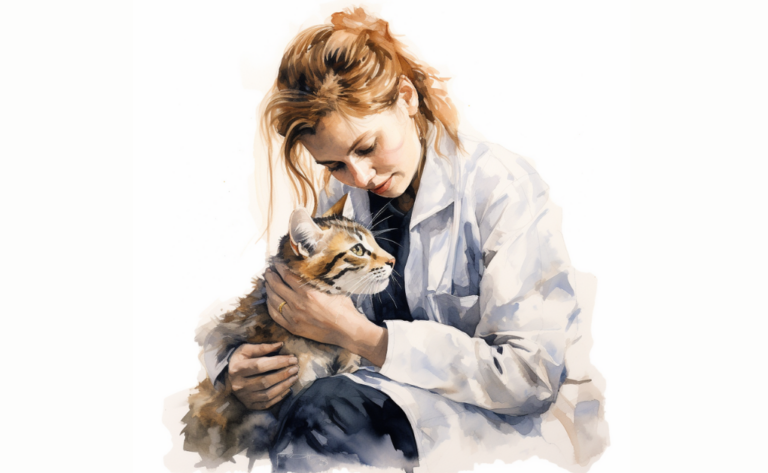What are Skin Masses on Cats?
What is it?
How is it Treated?
Breed Predispositions
No specific breeds of cats are known to be predisposed to skin masses. Skin masses can occur in cats of any breed or age.
Introduction
While grooming her beloved Persian cat, Fluffy, Amanda noticed a small, unusual lump on his skin. Concerned about this new discovery, she promptly scheduled a visit to the veterinarian to have it examined.
Skin masses on cats, often referred to as tumors that may be felt on the skin, are unusual growths, lumps, and bumps often found on the skin’s surface. These types of bumps, varying in size, shape, and texture, come into existence when there is an abnormal or excessive proliferation of cells in a particular skin area.
Numerous elements can trigger the development of these skin masses, affecting the skin in distinct ways, and they’re commonly seen in cats, particularly older cats. Understanding the underlying mechanisms that cause such growths to appear and grow on the skin is vital for appropriately treating the skin condition and the overall care of the cat. The presence and characteristics of these lumps may hint towards specific processes occurring within the cat’s body.
Types of Skin Masses in Cats
In the feline world, skin masses are divided into two broad categories: benign and malignant. Here’s an explanation of both:
Benign Skin Masses
Benign skin masses are non-cancerous growths that do not metastasize or spread to other body parts. These masses typically exhibit slow growth and do not invade the surrounding tissues. In cats, common examples of benign skin masses include:
- Skin tags
- Lipomas (fatty tumors)
- Papillomas (wart-like growths)
- Sebaceous cysts
- Basal cell tumors
Though benign skin masses are not life-threatening, they can sometimes lead to discomfort or aesthetic concerns.
Malignant Skin Masses
Malignant skin masses, synonymous with cancerous or malignant tumors, are growths that risk invading nearby tissues and spreading or metastasizing to other parts of the body. These masses can be aggressive and significantly endanger the cat’s health. Common types of malignant skin masses or cat skin cancer in cats include:
- Squamous cell carcinoma or cutaneous SCC
- Mast cell tumors or cutaneous mast cell tumors (cutaneous MCT)
- Melanomas
- Fibrosarcomas
Prompt diagnosis and treatment are crucial for malignant skin masses to inhibit further progression and potential spread.
It’s essential to recognize that the outward appearance of a skin mass or lesion does not necessarily denote whether it’s benign or malignant. Precise diagnosis necessitates a comprehensive evaluation by a veterinarian. This typically includes a physical examination, fine-needle aspiration or biopsy, and, at times, supplementary imaging or laboratory tests.
Treatment options hinge on the specific type and characteristics of the skin mass and the cat’s overall health. Siamese cats, among other breeds, can be susceptible to certain skin masses.
Causes of Skin Masses on Cats
Several conditions, including allergies, parasites, cancer, and other health problems, often cause these lumps and bumps. Some cases of skin mass are harmless, while others can lead to severe medical complications.
Skin masses in cats can arise due to a plethora of reasons. Here are some typical causes of skin masses or skin lumps in cats, along with an in-depth explanation for each:
- Inheritance: Certain inherited conditions or predispositions can heighten the likelihood of cats developing skin masses. These genetic elements may control the growth and development of cells, resulting in irregular tissue growth. Examples encompass familial cutaneous lipomas, which implies a genetic susceptibility to develop fatty tumors, and certain skin cancers with a hereditary component.
- Inflammation or Irritation: Chronic inflammation or skin irritation can give rise to skin masses. This can be brought about by various elements such as allergic responses, dermatitis, insect stings, or persistent scratching or licking of a particular area. Sustained irritation or inflammation can activate atypical cell growth and the creation of masses.
- Infections: Viral or bacterial infections can sometimes contribute to developing skin masses. For instance, feline papillomavirus can instigate the creation of papillomas or warts on the skin. Bacterial infections caused by certain bacteria can result in abscesses or pyoderma, manifesting as skin masses.
- Environmental Factors: External factors can also significantly develop skin masses on a cat’s skin. Exposure to certain carcinogens like sunlight or chemicals can escalate the risk of skin cancer. Trauma or damage to the skin, inclusive of chronic wounds or scars, can also culminate in the formation of masses.
- Hormonal Changes: Imbalances or alterations in hormone levels can add to the development of specific skin masses. For instance, hormone-responsive alopecia is a condition that can induce hair loss and the creation of skin masses in cats. Hormonal influences can impact the growth and multiplication of skin cells, thereby leading to the development of masses.

It’s worth noting that pinpointing the exact cause of a skin mass in a cat may necessitate a comprehensive examination and diagnostic tests conducted by a veterinarian. The underlying cause will guide the suitable treatment approach and prognosis for the cat, which may be particularly pertinent for middle-aged and older cats where such issues are more common. This condition can affect cats in various areas, often seen in cats on the head and neck, and may even impact the lymph nodes.
What are the Symptoms of Skin Tumors in Cats?
The indicators of skin masses in cats can fluctuate based on the root cause and the attributes of the mass. Here are some typical feline cancer symptoms associated with skin masses in cats:
- Manifestation of a visible lump or bump
- Alteration in appearance
- Hair loss
- Itching or scratching, leading to lumps and bumps
- Bleeding
- Shifts in behavior or activity levels
Recognizing that these symptoms are common in cats and can also be linked with other skin conditions is crucial. If you observe any unusual lumps, bumps, or alterations in your cat’s skin, it is recommended to consult with a veterinarian. The veterinarian may carry out a proper examination and diagnosis. Skin masses may be a common skin issue in cats, but each tumor type can present differently.
Diagnosis for Feline Skin Masses
Physical Assessment
The veterinarian will visually inspect the skin mass and surrounding regions during a physical evaluation. They will document the mass’s size, shape, hue, texture, and other features. The vet may gently probe the mass to assess its firmness and movement. Further, they will scrutinize the rest of the feline friend’s body for any other skin anomalies or related symptoms.
Fine Needle Aspiration (FNA)
Fine Needle Aspiration (FNA) is a diagnostic procedure frequently employed to collect a cell sample from the skin mass. The veterinarian gently draws cells from the mass using a slender needle attached to a syringe. These cells are then spread onto a slide and dyed for microscopic inspection. FNA assists in determining whether the mass is benign or malignant by evaluating the cells’ type and characteristics.

Tissue Sample
Sometimes, a biopsy might be needed to acquire a larger tissue sample for a more precise diagnosis. There are various biopsies, including punch, incisional, and excisional. Depending on size and placement, the veterinarian surgically extracts a part or the entire mass during a biopsy.
The tissue sample is then forwarded to a lab for histopathological scrutiny, where a veterinary pathologist examines the cells and tissue under a microscope to ascertain the mass’s nature.
Imaging Techniques
In certain circumstances, imaging methods like X-rays, ultrasound, or advanced imaging modalities like CT scans or MRI might be used.
These imaging methods assist in assessing the skin mass’s position, depth, and extent, especially if it involves underlying structures or suspicion of metastasis (spread) to other body areas.
The specific diagnostic approach will hinge on factors such as the skin mass’s appearance, placement, the cat’s overall health, and the veterinarian’s clinical judgment. It’s crucial to consult a veterinarian if you find a lump or skin masses on your cat to ensure an accurate diagnosis and suitable treatment plan. Soft tissue masses are often seen in young cats, and most can be diagnosed with a simple physical examination and imaging studies.
If you feel a lump, it is essential to seek professional help, as the early stages of benign tumors or malignant lumps and bumps can be effectively managed. Given the complexity and potential threat, a veterinarian will likely also look for signs of internal organ involvement, like bone marrow or white blood cell abnormalities, especially as some skin tumors tend to spread to the surrounding tissue.
Treatment of Skin Masses in Cats
Surgical Removal
Surgical removal is a frequently chosen treatment for skin masses in cats, particularly if the mass is found to be cancerous or if it causes discomfort or impedes the cat’s quality of life. During this operation, the veterinarian surgically extracts the mass along with a boundary of healthy tissue to guarantee complete elimination. The complexity of the surgery hinges on the size and location of the mass. The incision site is sealed post-excision using sutures or alternative wound closure techniques. The removed mass may be dispatched for laboratory evaluation to identify the cellular nature and validate the diagnosis.
Cryotherapy
Cryotherapy incorporates the use of extremely low temperatures to obliterate abnormal cells. Cryogenic substances like liquid nitrogen are directly applied to the skin mass, leading to freezing and cellular death. Cryotherapy is often utilized for small, benign skin masses or in scenarios where surgical removal isn’t feasible. This procedure is typically fast, and the cat might need mild sedation or local anesthesia.
Laser Surgery
Laser surgery serves as another treatment alternative for certain types of skin masses. It employs a concentrated light energy beam to eliminate or destroy the abnormal cells precisely. Laser surgery provides multiple benefits, such as decreased bleeding, lesser postoperative pain, and a quicker recovery than conventional surgical techniques. The specific type of laser used will be dictated by the skin mass’s characteristics and the veterinarian’s expertise.
Radiation Therapy
Radiation therapy might be suggested when the skin mass is cancerous or can’t be wholly surgically excised. This therapy utilizes high-energy radiation to target and obliterate cancer cells. It is usually delivered in several sessions spanning a few weeks. The treatment is meticulously planned and administered to minimize side effects and safeguard healthy surrounding tissues.
Chemotherapy
In cases where the skin mass is cancerous with the potential to metastasize to other body parts, chemotherapy may be employed. This cancer treatment involves using drugs that target and eliminate rapidly dividing cancer cells. The specific chemotherapy protocol will depend on the cancer type and stage. Depending on the drug and the cat’s requirements, it may be administered orally, intravenously, or topically.
The chosen treatment method will hinge on various factors, including the type and nature of the skin mass, its location, and the older cat’s overall health. If you find a lump, it is crucial to consult a veterinarian to ascertain the most suitable treatment plan for your cat’s circumstance. Given the risk of developing more severe conditions, a veterinarian may recommend surgery to remove the tumor to treat skin masses.
Prevention for Feline Skin Masses
To help mitigate the risk of skin masses, including common skin lumps and bumps that can affect areas of the body such as around the head and neck, cat owners can undertake the following steps:
- Frequent Skin Checks: Implement routine checks on your cat’s skin to spot any unusual growths, lumps, or alterations within the skin. Watch for abnormal growths, unhealing sores, or inflammation areas.
- Maintain Grooming: Regular grooming sessions are key in preserving the health of your feline friend’s skin and coat and a chance to notice any abnormalities. Brushing your cat’s fur assists in removing loose hair and minimizing the risk of matting, which could lead to skin irritations.
- Balanced Diet: Providing a nutritionally balanced diet to your cat supports overall health and immune system function. Please consult a veterinarian to ensure your cat’s diet meets its nutritional requirements.
- Parasite Prevention: Employ suitable flea and tick prevention measures to reduce the risk of parasitic invasions. Parasites can lead to skin irritations and possibly cause secondary infections or the development of skin masses.
- Minimize Sun Exposure: If your cat spends time outdoors, ensure they have access to shade and limit their exposure to direct sunlight. Sunburn and extended sun exposure can contribute to skin damage and the growth of skin masses, especially in cats with light-colored or hairless coats.
- Maintain Cleanliness: Upholding a clean living environment for your cat is critical, as poor hygiene could lead to skin infections or irritations. Regularly clean their bedding, litter box, and living areas to minimize the risk of bacterial or fungal growth.
- Frequent Vet Check-ups: Arrange regular check-ups with a veterinarian to monitor your cat’s health. They can perform comprehensive examinations and address any skin issues or abnormalities.
- Spay/Neuter: Spaying or neutering your cat could help lower the risk of specific conditions related to the reproductive system, including mammary tumors or hormonal imbalances that can impact the skin.
- Avoid Harmful Substances: Shield your cat from chemicals, toxins, and irritants that can harm the skin’s layers. This includes household cleaning products, certain plants, and other substances that could cause skin or allergic reactions.
Implementing these preventive measures can help pet owners reduce the risk of skin masses, including fatty tumors that often develop within the skin layers, and promote their cats’ overall health and well-being. Regular monitoring, good hygiene practices, and critical veterinary care are essential for early detection and prompt treatment for your cat if skin abnormalities are spotted. Just by regularly petting your cat, you could notice new tumors that aren’t visible.
Frequently Asked Questions
Disclaimer: The information provided on this veterinary website is intended for general educational purposes only and should not be considered as a substitute for professional veterinary advice, diagnosis, or treatment. Always consult a licensed veterinarian for any concerns or questions regarding the health and well-being of your pet. This website does not claim to cover every possible situation or provide exhaustive knowledge on the subjects presented. The owners and contributors of this website are not responsible for any harm or loss that may result from the use or misuse of the information provided herein.







